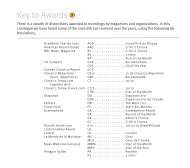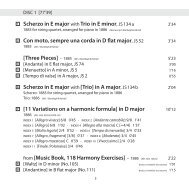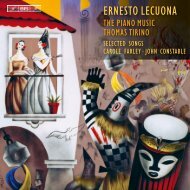MENDELSSOHN - Bis
MENDELSSOHN - Bis
MENDELSSOHN - Bis
You also want an ePaper? Increase the reach of your titles
YUMPU automatically turns print PDFs into web optimized ePapers that Google loves.
piano begins the slow introduction (An dante) with a series of arpeggio chords,<br />
after which it presents a rapid, rhythmic motif which conjures up ascend ing runs<br />
from the orchestra. This theme is developed by the soloist and orchestra into an<br />
Alle gro con fuoco.<br />
Mendelssohn was to compose two further short er, virtuoso concert pieces for<br />
piano and orch estra. The Rondo brillant, Op. 29, was completed on 29th Jan uary<br />
1834. Structurally it is a normal rondo in which the main theme, after its initial<br />
pre sen tation, recurs three times – and is not confined exclusively to the piano.<br />
The epi sodes in between are based on com pletely different themes, rich in variety,<br />
and the piano frequently plays in unison with the orchestra. The work is dedicated<br />
to the pianist and composer Ignaz Moscheles, a pupil of Beet hoven. A letter<br />
which Men delssohn wrote to Moscheles gives cause for us to doubt that the com -<br />
poser was gen uinely satisfied with his Rondo brillant: ‘In this Rondo I have been<br />
struck once again by my own shortage of new ideas for the piano. These are the<br />
places at which I always hesitate and torment myself, and I fear that you will<br />
notice. Otherwise there is much in it that I like, and I find some passages very<br />
pleas ing.’<br />
There remains his last work for piano and orch estra, the Serenade and Allegro<br />
giocoso, Op. 43, which was completed on 11th April 1838 (a year after the Second<br />
Piano Concerto, Op. 40). In the opening Serenade the piano is dominant, while<br />
the orch estra’s role is limited to entries that rarely last longer than one bar. There<br />
are many arpeggio chords, but these colour rather than develop the musical mat -<br />
erial. The Serenade is in B minor, and thus has the same key signature as the D<br />
major Allegro giocoso. It seems likely that Mendelssohn had no ambitions with<br />
this extro vert work beyond providing enter tainment and amusement.<br />
43








